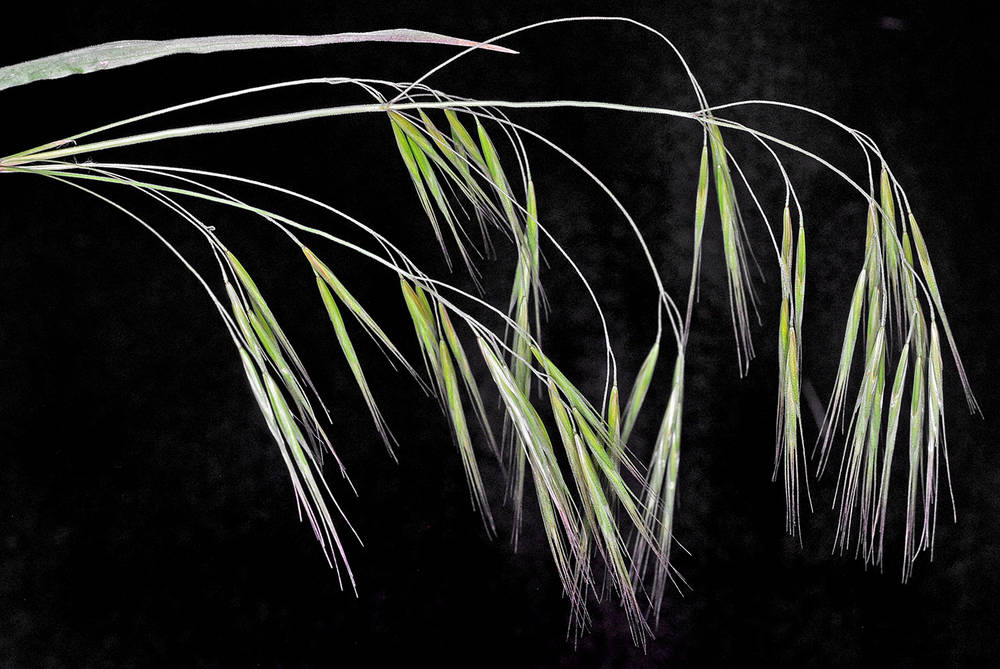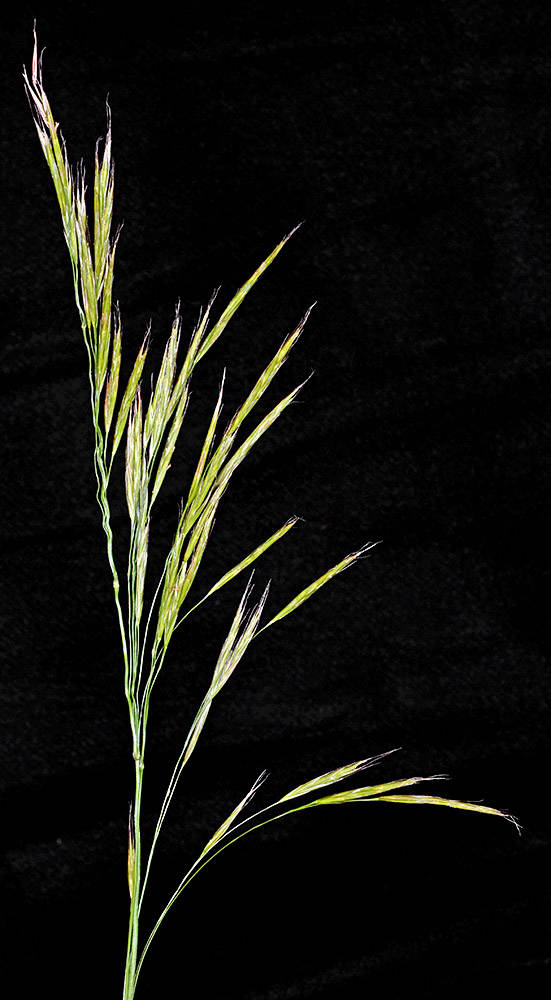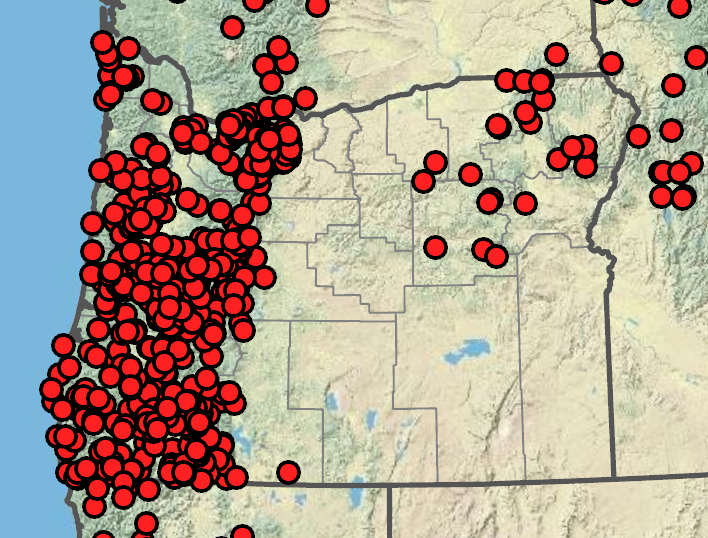Bromus tectorum
Bromus vulgaris
cheatgrass, downy brome, downy chess
Columbia brome
puberulent.
internodes glabrous;
nodes (3)4–6(7), usually pilose.
sheaths densely and softly retrorsely pubescent to pilose; upper sheaths sometimes glabrous;
blades 1–16 cm × 1–6 mm, softly hairy on both surfaces.
sheaths pilose or glabrous;
ligules 2–6 mm;
blades 13–25(33)cm × up to 14 mm; flat; upper and lower surfaces usually glabrous, sometimes pilose.
5–20 × 3–8 cm; open, nodding;
branches 1–4 cm, drooping, 1-sided and longer than the spikelets, usually at least 1 branch with 4–8 spikelets.
10–15 cm, usually narrow, nodding; the branches ascending to appressed.
10–20 mm, moderately laterally compressed, not densely crowded, 4–8 florets.
15–30 mm, elliptic to lanceolate; terete to moderately laterally compressed, with (3)4–9 florets.
villous, pubescent, or glabrous;
lower glumes 4–9 mm, 1-veined;
upper glumes 7–13 mm, 3–5-veined.
glabrous or pilose;
lower glumes 5–8 mm, 1(3)-veined;
upper glumes 8–12 mm, 3-veined.
9–12 mm, lanceolate, glabrous or pubescent to pilose, 5–7-veined;
tips acuminate; hyaline; bifid, with teeth 0.8–2(3)mm, awned;
lemma awns 10–18 mm; straight.
8–15 mm, lanceolate, rounded over the back; backs sparsely hairy or glabrous;
margins coarsely pubescent, sometimes glabrous;
tips subulate to acute; entire, awned;
lemma awns (4)6– 12 mm; straight.
0.5–1 mm.
2–4 mm.
=14.
=14.
Bromus tectorum
Bromus vulgaris
Disturbed areas, sagebrush steppe, degraded grasslands, roadsides. 0–2400 m. BR, BW, Casc, Col, CR, ECas, Lava, Owy, Sisk, WV. CA, ID, NV, WA; throughout North America; worldwide. Exotic.
Bromus tectorum is a relatively short grass with drooping inflorescences. Similar B. sterilis and B. diandrus have longer glumes, lemmas, and awns, and spikelets that hang down at a shallower angle than those of B. tectorum. The introduction of B. tectorum to shrub steppe habitats during a time of massive overgrazing in the late 1800s has made restoration of native plant communities difficult or impossible, even where grazing no longer occurs. Fast-growing B. tectorum seedlings outcompete slower growing native grass seedlings for water in drying soils. At maturity, the awns make B. tectorum unpalatable to livestock.
Forests, in shade or partial shade. 0–2400m. BW, Casc, CR, ECas, Est, Sisk, WV. CA, ID, WA; north to British Columbia, northeast to Alberta, east to WY. Native.
Bromus vulgaris is a common forest grass of western Oregon and the Blue and Wallowa mountains. Its closed sheaths with spreading hairs and its long, narrow spikelets distinguish it from most other woodland grasses. Invasive Brachypodium sylvaticum has similar nodding inflorescences with long spikelets, but all the spikelets are connected directly to the inflorescence axis by very short, unbranched stalks, and the leaf sheath margins are overlapping.
Barbara Wilson, Richard Brainerd, Nick Otting
Barbara Wilson, Richard Brainerd, Nick Otting
- Local floras:
BC,
CA,
OR,
WA
- Local Web sites:
CalFlora,
CalPhotos,
Flora NW,
PNW Herbaria
WildflowerSearch
iNaturalist (observations)
USDA Plants Database
- LBJ Wildflower Center
- SEINet
- Plants of the World Online
- Encyclopedia of Life
- Wikipedia
- Google Image Search
- Local floras:
BC,
CA,
OR,
WA
- Local Web sites:
CalFlora,
CalPhotos,
Flora NW,
PNW Herbaria
WildflowerSearch
iNaturalist (observations)
USDA Plants Database
- LBJ Wildflower Center
- SEINet
- Plants of the World Online
- Encyclopedia of Life
- Wikipedia
- Google Image Search





